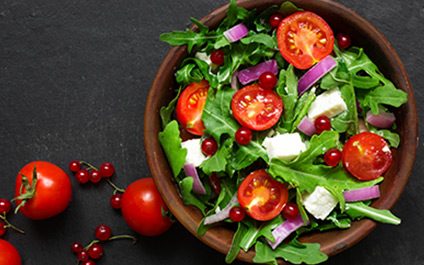
We all like to feel a little healthier when we order a salad when we go out to eat. All those greens and veggies HAVE to be good for us, right? Well, as healthy as we may think we are as we’re eating our salad, truth is, you may not be doing yourself any favors. Take a look at some things that could be adding hundreds and even thousands of calories to your salad…
Fried meat. This might seem like a no brainer, but many times we overlook things on top of the salad because, well, it is a salad after all, right? When you get that fried chicken salad you could be doubling or even tripling the amount of fat and calories of that of a baked or grilled version. Not to mention the process of frying alters the nutrients contained in food and adds unhealthy saturated fat. The right choice? Choose baked or grilled chicken or fish as your protein choice.
Cheese. Cheese by itself is not necessarily bad, and it can add a healthy amount of protein to your salad. But restaurants often times (let’s just say more times that not) aren’t too worried about portion sizes… so the amount of cheese they put in your salad can sometimes add as much as 400-500 calories; and that is just for cheese! And cheese is made of protein and fat so if you have 400 calories worth of cheese, this is somewhere around 35-45 grams of fat; this may not sound too bad, but that isn’t including anything else that is on your salad! That’s a lot. Too much cheese (dairy) can also affect your skin, sinuses, and allergies. While you do need healthy fats in your salad, it is better to get these from foods like avocados or nuts which will leave you with clear skin from healthy Vitamin E, as well as healthy omega 3s. If you are ordering a salad with cheese, pay attention to the KIND of cheese. A low fat version (like mozzarella or feta) is not something to be too concerned about (it will add minimal fat and calories), but if they’re piling cheddar or blue cheese on top, perhaps a smart decision is to ask for it on the side or hold it altogether.
Dressing. Many of us already know or have heard that creamier dressings contain more fat, and this is totally true. A vinaigrette or oil based dressing is, in most cases, a healthier option. However, the amount used can affect the fat and calorie count in your salad. Like I said, restaurants aren’t too concerned with your calorie intake or portion sizes, so many times they just douse that salad with loads of dressing. Ask for the dressing on the side so you can control the portion.
Dried fruit. The word “fruit” is kind of like the word “salad”… we hear it or say it and automatically think healthy. While there are tons of nutrients and vitamins in fruit, fruit is also full of something else: sugar. Some fruits are lower in sugar than others, but dried fruit is even higher in sugar than their fresh counterparts. Why? The dehydration process removes much the the water and what is left is a lot of sugar; it also reduces the volume so you get more per serving (for example, a cup of grapes has about 104 calories, and a cup of raisins has over 434 calories). In addition, many manufacturers add even MORE sugar after they have been dried so take away a little tartness, so the result is sugar overload. Two tablespoons of dried sweetened cranberries on your salad can add as much sugar as a soda! Restaurants throw dried cranberries and raisins on top of your salad letting you think you’re getting a nice healthy serving of fruit, but as a matter a fact it’s more like a healthy serving of diabetes… if you’re going to get dried fruit, choose the amount you consume in your salad or buy it yourself so you know the ingredients and can control the portion size and add it to your salads at home. The best option for fruit on a salad is always fresh fruit!

